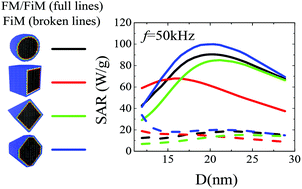Universal distribution of magnetic anisotropy of impurities in ordered and disordered nanograins
A. Szilva, P. Balla, O. Eriksson, G. Zaránd, and L. Szunyogh
Phys. Rev. B 91, 134421 (2015)
A blog dedicated to recent publications in the field of Nanomagnetism. A selection of links to articles in the most important topics of magnetism of nanoparticles and nanostructures will appear here in a regular basis. Comments and discussion about the results will be welcome.
Tuesday 28 April 2015
Friday 24 April 2015
Hyperthermia in core/shell NP by Monte Carlo
Susceptibility losses in heating of magnetic core/shell nanoparticles for hyperthermia: a Monte Carlo study of shape and size effects.
M. Vasilakaki, C. Binns and K. N. Trohidou
Nanoscale 7, 7753 (2015)
M. Vasilakaki, C. Binns and K. N. Trohidou
Nanoscale 7, 7753 (2015)
Antiferromagnetic-Core/Ferrimagnetic-Shell NP
Enhanced Magnetic Properties in Antiferromagnetic-Core/Ferrimagnetic-Shell Nanoparticles.
Marianna Vasilakaki, Kalliopi N. Trohidou, Josep Nogués
Scientific Reports 5, 9609 (2015)
Marianna Vasilakaki, Kalliopi N. Trohidou, Josep Nogués
Scientific Reports 5, 9609 (2015)
Tuesday 21 April 2015
Control of NP Arrangement for Magnetic Hyperthermia
Nano-objects for Addressing the Control of Nanoparticle Arrangement and Performance in Magnetic Hyperthermia.Irene Andreu, Eva Natividad, Laura Solozábal, and Olivier Roubeau
ACS Nano 9, 1408 (2015)
ACS Nano 9, 1408 (2015)
Scaling approach to MC simulations of magnetic models
Bridging the gap between discrete and continuous magnetic models in the scaling approach. E. A. Velásquez, J. Mazo-Zuluaga, P. Vargas, and J. Mejía-López
Phys. Rev. B 91, 134418 (2015)
Phys. Rev. B 91, 134418 (2015)
| Collapsed phase diagram for different scaling λ values. The inset shows the phase diagram for some selected scaling values, i.e., before the scaling up process. |
Friday 10 April 2015
Design of compensated ferrimagnetic Heusler alloys for giant tunable exchange bias : Nature Materials : Nature Publishing Group
Design of compensated ferrimagnetic Heusler alloys for giant tunable exchange bias.
Ajaya K. Nayak, Michael Nicklas, Stanislav Chadov, Panchanana Khuntia, Chandra Shekhar, Adel Kalache, Michael Baenitz, Yurii Skourski, Veerendra K. Guduru, Alessandro Puri, Uli Zeitler, J. M. D. Coey, Claudia Felser
Nature Materials 14, 679 (2015)
Ajaya K. Nayak, Michael Nicklas, Stanislav Chadov, Panchanana Khuntia, Chandra Shekhar, Adel Kalache, Michael Baenitz, Yurii Skourski, Veerendra K. Guduru, Alessandro Puri, Uli Zeitler, J. M. D. Coey, Claudia Felser
Nature Materials 14, 679 (2015)
Tuesday 7 April 2015
Magnetoelastic coupling from first principles
General microscopic model of magnetoelastic coupling from first principles.
X. Z. Lu, Xifan Wu, and H. J. Xiang
Phys. Rev. B 91, 100405(R) (2015)
X. Z. Lu, Xifan Wu, and H. J. Xiang
Phys. Rev. B 91, 100405(R) (2015)
Nanocrystal Superlattices induced by magnetic forces
Beyond Entropy: Magnetic Forces Induce Formation of Quasicrystalline Structure in Binary Nanocrystal Superlattices.
Zhijie Yang, Jingjing Wei, Pierre Bonville, and Marie-Paule PileniJACS 137, 4487 (2015)
Autoresonant switching of NPs
Autoresonant switching of the magnetization in single-domain nanoparticles: Two-level theory.
Guillaume Klughertz, Lazar Friedland, Paul-Antoine Hervieux and Giovanni Manfredi
Phys. Rev. B 91, 104433 (2015)
Guillaume Klughertz, Lazar Friedland, Paul-Antoine Hervieux and Giovanni Manfredi
Phys. Rev. B 91, 104433 (2015)
Low-energy excitations in geometrically frustrated magnets
Evidence for unidimensional low-energy excitations as the origin of persistent spin dynamics in geometrically frustrated magnets.
A. Yaouanc, P. Dalmas de Réotier, A. Bertin, C. Marin, E. Lhotel, A. Amato, and C. Baines
Phys. Rev. B 91, 104427 (2015)
A. Yaouanc, P. Dalmas de Réotier, A. Bertin, C. Marin, E. Lhotel, A. Amato, and C. Baines
Phys. Rev. B 91, 104427 (2015)
Subscribe to:
Posts (Atom)




